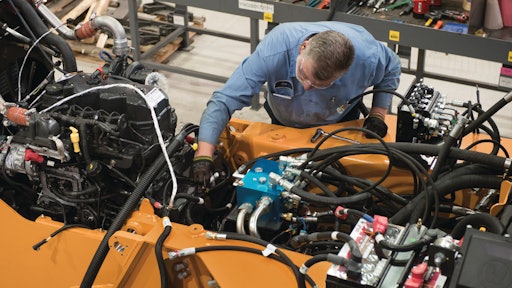
What’s so bad about a few drops of oil?
Try this: Three drops of oil a minute leaking from one connector in your hydraulic system will cost you $168 a year just in replacement oil. Let's address the many costs and risks associated with hydraulic system oil leaks, possible causes and how you can prevent system leaks.
Oil Leak Calculator
In my three-drops a-minute example you’d leak 9.3 gallons in a year. At about $18 per gallon for oil, it adds ups to $168 per leak point. And remember, this is for one leak point. Multiple leak points can drive the loss and cost of hydraulic oil up significantly over the course of one year.
You can calculate the approximate cost of lost fluid plant-wide using Parker Hannifin's Oil Leak Calculator.
The additional costs of an oil leak — those not always considered — are more than the kitty litter you use to sop it up. There are energy losses, warranty issues, safety hazards, environmental issues, hazardous waste disposal, downtime for repairs and rising insurance premiums. All can result in lost revenue and increased MRO costs.
Plus, escalating EPA and OSHA scrutiny makes avoiding the consequences of hydraulic system leaks — fines and possible litigation — ever more important.
Taking steps to prevent leaks makes sense
It all starts with understand the common causes of leaks. Number one — we find it in 60% of all leak instances — is improper installation. Most often, the wrong fitting connections were chosen for the job. Here’s a quick overview of the most common connector types and the most likely cause for them to leak:
- 37° flare — the most common fitting in the world, usually subjected to improper torque during assembly.
- O-ring face seal — O-ring pinched, not seated in groove or missing.
- 24° flareless — also known as flareless bite type fittings, improper presetting of the ferrule on the tube.
System design — incorrect routing, bending or clamping — is the second most common cause of leaks, accounting for about 20% of those we see.
Third is poor quality components, which account for 15% of leak causes. Avoid low quality fittings that are flooding the market. If you can’t ID the manufacturer, don’t use them.
The final 5% of leaks are the result of system abuse — usually poor maintenance practices.
Cleaning up the mess
If you have a leak, keep in mind the legal and environmental reporting requirements. Follow these steps to correct and report the problem:
- Stop the leak/release
- Contain the leak/release
- Clean up the leak/release (necessary training/certification of clean up personnel will vary depending on the type/amount of oil and the media impacted; e.g. soil, groundwater, wildlife habitat, etc.)
- Dispose of or remediate impacted media
- Dispose of contaminated devices
- Replace contaminated devices
- Report leak/release (if required) to applicable government agencies (e.g. EPA, Coast Guard); follow up with regulators
- Implement a corrective action to prevent a future, similar leak/release
- Modify leak/release control plans, if required
The keys to avoiding a hydraulic system leaks are the same as the causes: ensuring proper fitting selection and installation, using high-quality components from reputable manufacturers and maintaining a regular maintenance program with MRO personnel trained in hydraulic connections and safety practices. Should a leak occur, identify the release point and contain it as soon as possible.
Content originally published on Parker Hannifin's blog by Burleigh Bailey, Research & Development - Engineering Manager, Parker Tube Fittings Division.




























